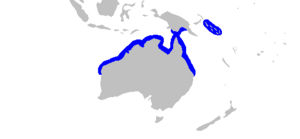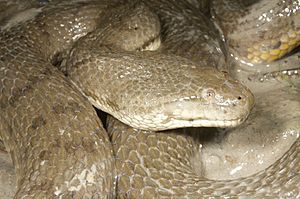Nervous shark facts for kids
Quick facts for kids Nervous shark |
|
|---|---|
 |
|
| Conservation status | |
| Scientific classification | |
| Genus: |
Carcharhinus
|
| Species: |
cautus
|
 |
|
| Range of the nervous shark | |
| Synonyms | |
|
Galeolamna greyi cauta Whitley, 1945 |
|
The nervous shark (Carcharhinus cautus) is a type of requiem shark. It belongs to the Carcharhinidae family. It gets its name because it can be quite shy around people.
This shark is often found in shallow, coastal waters. You can see it off northern Australia, Papua New Guinea, and the Solomon Islands. It's a small shark, usually about 1.0 to 1.3 meters (3.3 to 4.3 feet) long. It has a brownish or grayish color. Its snout is short and blunt, and its eyes are oval. It also has a fairly large second dorsal fin (the fin on its back). The edges of most of its fins have thin black lines. The lower part of its tail fin is also tipped in black.
Nervous sharks mainly eat small bony fishes. They might also eat crustaceans like crabs, molluscs, and even snakes. These sharks give birth to live young, much like mammals. The baby sharks grow inside the mother, getting food through a special connection called a placenta. How they reproduce can change depending on where they live. For example, the time of year they breed and how long the babies stay inside the mother can be different. Females usually have one to six pups either every year or every two years.
The nervous shark is harmless to humans. Sometimes, it gets caught by accident in fishing nets, especially those used near the coast. However, the International Union for the Conservation of Nature (IUCN) says this shark is of "Least Concern" for its survival. This means its population is stable and not currently threatened.
Contents
About the Nervous Shark's Name
An Australian scientist named Gilbert Percy Whitley first described the nervous shark in 1945. He called it cauta, which means "cautious" in Latin. He chose this name because the shark seemed shy when it met people. Later, other scientists decided it was its own unique species. They placed it in the group of sharks called Carcharhinus.
Scientists have studied the nervous shark's body and its genes. They believe it is closely related to the blacktip reef shark.
What the Nervous Shark Looks Like
The nervous shark has a strong, streamlined body. Its snout is short and rounded. Each nostril has a small, nipple-shaped flap. Its eyes are oval and have special eyelids called nictitating membranes that can cover them.
The shark's mouth does not have deep grooves at the corners. It has many rows of teeth. The upper teeth are narrow and angled with rough, saw-like edges. The lower teeth are thinner and straighter with finer edges. It has five pairs of gill slits, which are medium in size.
Its pectoral fins (side fins) are medium in length, narrow, and pointed. The first dorsal fin (the main fin on its back) is large and shaped like a sickle. The second dorsal fin is also quite large and sits opposite the anal fin (the fin near its tail). There is no ridge between its dorsal fins.
Just before its tail fin, there's a crescent-shaped dip on its body. The tail fin itself is not symmetrical. It has a strong lower part and a longer upper part. The shark's skin is covered in tiny, overlapping scales called dermal denticles. These scales have ridges that lead to small teeth.
The nervous shark is bronze to gray on top and white underneath. It has a white stripe along its side. A thin black line runs along the front edges of its dorsal fins, pectoral fins, and the upper part of its tail fin. The lower part of its tail fin, and sometimes its pectoral fins, are tipped in black.
These sharks usually grow to be 1.0 to 1.3 meters (3.3 to 4.3 feet) long. Some can even reach 1.5 meters (4.9 feet). Female nervous sharks tend to grow larger than males.
Where Nervous Sharks Live
The nervous shark lives on continental and island shelves off northern Australia. This area stretches from Shark Bay in the west to Moreton Bay in the east. They are also found off Papua New Guinea and around the Solomon Islands.
This shark is very common in places like Darwin Harbor, the Gulf of Carpentaria, and Shark Bay. It usually lives in shallow inshore waters, up to at least 45 meters (148 feet) deep. They seem to prefer areas with mangrove trees and sandy or muddy bottoms. They tend to avoid places with lots of seagrass.
What Nervous Sharks Eat
Nervous sharks mostly eat small bony fishes. This includes fish like silversides, smelt-whitings, wrasses, and grunters. They also eat crustaceans such as prawns, crabs, and mantis shrimps. Sometimes, they eat molluscs like squids, clams, and snails. They have even been known to eat semi-aquatic snakes, like Cerberus rynchops and Fordonia leucobalia.
Nervous Shark Reproduction and Life Cycle
Like other requiem sharks, the nervous shark gives birth to live young. This is called viviparous reproduction. When the baby sharks are growing inside the mother, they first use up their yolk for food. After that, the mother provides them with nutrients through a special connection, similar to a placenta in mammals.
Female nervous sharks have one working ovary (on the right side) and two working uteruses. When sharks mate, the male bites the sides of the female. After mating, the female can store the male's sperm for about four weeks before the eggs are fertilized.
In Darwin Harbor, nervous sharks mate from January to March. The babies are born in October and November, after about eight to nine months of pregnancy. In Shark Bay, mating happens from late October to early November. The babies are born around the same time the next year, after about 11 months of pregnancy. This longer pregnancy in Shark Bay might be because the water is cooler there.
Female nervous sharks in Darwin Harbor have babies every year. In Shark Bay, they have babies every two years. A female can have between one and six pups at a time. The number of pups does not depend on the mother's size.
The newborn sharks are quite large, measuring about 35 to 40 centimeters (14 to 16 inches) long. They are born in shallow areas that act as nurseries, like Herald Bight in Shark Bay. Young sharks grow quickly. Males become adults when they are about 84 to 91 centimeters (33 to 36 inches) long. Females become adults when they are about 91 to 101 centimeters (36 to 40 inches) long. Males reach adulthood around four years old, and females around six years old. Nervous sharks can live for at least 12 years (males) and 16 years (females).
Nervous Sharks and Humans
The nervous shark is shy and hard to get close to, so it is not dangerous to humans. Sometimes, these sharks are caught and sold for food.
They can be caught by accident in coastal fishing nets, especially those used for catching fish like barramundi. They might also be caught by fishing lines or in nets used for prawns. The number of nervous sharks in Australia does not seem to be threatened by fishing. Because of this, the International Union for Conservation of Nature (IUCN) has listed the nervous shark as "Least Concern".
See also
 In Spanish: Tiburón nervioso para niños
In Spanish: Tiburón nervioso para niños



